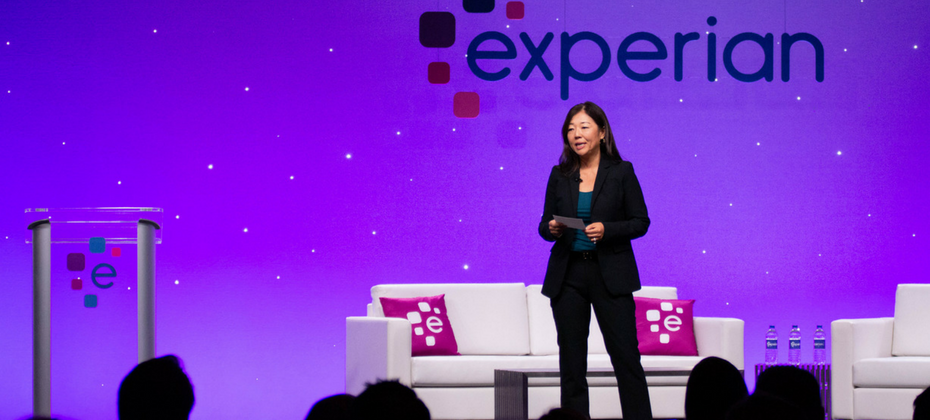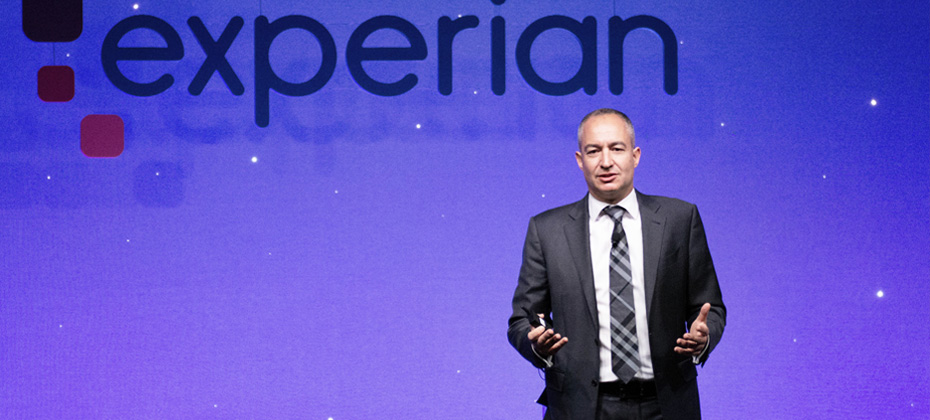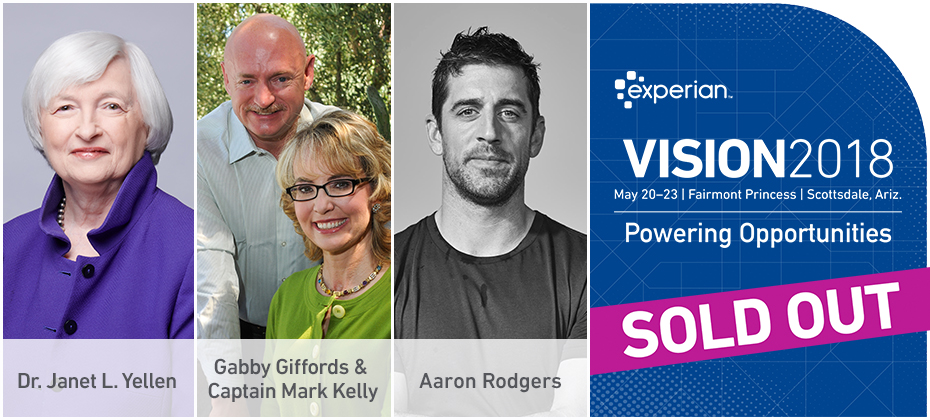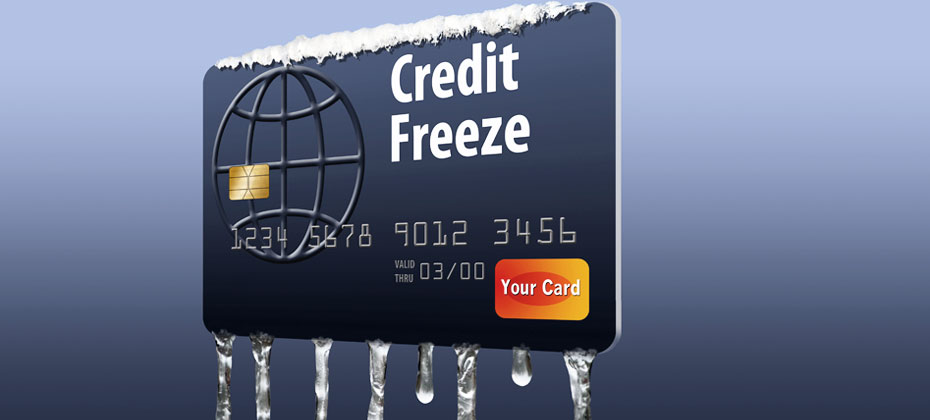Apply CIS Tag

The second full day of Experian Vision 2018 kicked off with an inspirational message from keynote speakers Capt. Mark Kelly and Former Congresswomen Gabby Giffords, rolled into a series of diverse breakout sessions, and concluded with Super Bowl-winning quarterback Aaron Rodgers sharing tales of sports, leadership and winning. Need a recap of some of the headlines from the day? Here you go ... Retail Apocalypse? Not so fast alarmists. Yes, there are media headlines around mergers, closings and consumers adopting new ways to shop, but let me give you three reasons as to why the retail sky is not falling. There were more store openings last year than closings, and that trend is expected to continue this year with an estimated 5,500 openings by December. There continues to be a positive sales trajectory. E-commerce sales are increasing. Big department stores have seen pains, but if brands are focused on connection, relevance and convenience, there is hope. Consumers continue to spend. Subprime auto bubble? Nope. Malinda Zabritski, Sr. Director of Experian Automotive Sales, says the media likes to fixate on the subprime, but subprime financing has been on the decline, reaching record lows. Deep subprime is at .65%. Additionally, delinquency rates have also tapered. The real message? Consumers are relying on auto lenders for financing, largely due to consumer preferences to lease. The market is healthy, and while it has slowed slightly, the market is still at 7% year-over-year growth. Consumer-permissioned data is not just a value-add for thin-file consumers. Take for instance the inclusion of demand deposit accounts (DDAs). David Shellenberger, Sr. Director of Scoring and Predictive Analytics for FICO, says people who have had long relationships with their checking accounts tend to be more stable and generally sport higher credit scores. Consumers with thick, mature files can also benefit with DDA data. Consumer-permissioned data is not just about turning a “no” to a “yes.” It can also take a consumer from near-prime to prime, or from prime to super-prime. Would you want to make a credit decision with less information or more? This was the question Paul DeSaulniers, Experian Sr. Director of Product, posed to the audience as he kicked off the session on alternative data. With an estimated 100 million U.S. consumers falling below “thick-file” credit status, there is a definite need to learn more about these individuals. By leveraging alternative credit data – like short-term lending product use, rental data, public records and consumer-permissioned data – a more holistic view of these consumers is available. A few more facts: While alternative finance users tend to be more subprime, 20% are prime or better. A recent data pull revealed 20% of approved credit card users also had alternative finance data on them as well. About 2/3 of households headed by young adults are rentals. Imagine a world where the mortgage journey takes only seven to 10 days. With data and technology, we are closer than you think. Future products are underway that could master the underwriting phase in just one day, leaving the remaining days dedicated for signing disclosures, documents and wiring funds. Processes need to be firmed up, but a vision has been set. The average 30- to 45-day mortgage journey could soon be a distant memory. 97% of online banking applications that are started are abandoned. Why? Filling out lengthy forms, especially on a mobile device, is not fun. New technology, such as Experian’s Instant Form Fill, is allowing consumers to provide a name, zip and last four numbers of their social security number for an instant form fill of the rest of the application. Additionally, voice assistants are expected to increasingly facilitate research on purchases big and small. A recent study revealed nearly half of consumers perceive voice assistants to be useful. Businesses have more fraud losses than ever before. Not surprising. What is scary? An estimated 54% of businesses said they are not confident in their ability to detect fraud. Another session reported that approximately 20% of credit charge-offs are synthetic IDs, a growing pain point for all businesses. Consumers, on the other hand, say they “want visible signs of security” and “no friction.” Tough to balance, but those are today’s expectations. More Vision 2018 insights can be accessed on #ExperianVision twitter feed. Vision 2019 will be in San Antonio, Texas next May 5-8.

Alternative credit data. Enhanced digital credit marketing. Faster, integrated decisioning. Fraud and identity protections. The latest in technology innovation. These were the themes Craig Boundy, Experian’s CEO of North America, imparted to an audience of 800-plus Vision guests on Monday morning. “Technology, innovation and new sources of data are fusing to create an unprecedented number of new ways to solve pressing business challenges,” said Boundy. “We’re leveraging the power of data to help people and businesses thrive in the digital economy.” Main stage product demos took the shape of dark web scans, data visualization, and the latest in biometric fraud scanning. Additionally, a diverse group of breakout sessions showcased all-new technology solutions and telling stats about how the economy is faring in 2018, as well as consumer credit trends and preferences. A few interesting storylines of the day … Regulatory Under the Trump administration, everyone is talking about deregulation, but how far will the pendulum swing? Experian Sr. Director of Regulatory Affairs Liz Oesterle told audience members that Congress will likely pass a bill within the next few days, offering relief to small and mid-sized banks and credit unions. Under the new regulations, these smaller players will no longer have to hold as much capital to cover losses on their balance sheets, nor will they be required to have plans in place to be safely dismantled if they fail. That trigger, now set at $50 billion in assets, is expected to rise to $250 billion. Fraud Alex Lintner, Experian’s President of Consumer Information Services, reported there were 16.7 million identity theft victims in 2017, resulting in $16.8 billion in losses. Need more to fear? There is also a reported 323k new malware samples found each day. Multiple sessions touched on evolving best practices in authentication, which are quickly shifting to biometrics-based solutions. Personal identifiable information (PII) must be strengthened. Driver’s licenses, social security numbers, date of birth – these formats are no longer enough. Get ready for eye scans, as well as voice and photo recognition. Emerging Consumers The quest to understand the up-and-coming Millennials continues. Several noteworthy stats: 42% of Millennials said they would conduct more online transactions if there weren’t so many security hurdles to overcome. So, while businesses and lenders are trying to do more to authenticate and strengthen security, it’s a delicate balance for Millennials who still expect an easy and turnkey customer experience. Gen Z, also known as Centennials, are now the largest generation with 28% of the population. While they are just coming onto the credit scene, these digital natives will shape the credit scene for decades to come. More than ever, think mobile-first. And consider this … it's estimated that 25% of shopping malls will be closed within five years. Gen Z isn’t shopping the mall scene. Retail is changing rapidly! Economy Mortgage originations are trending up. Consumer confidence, investor confidence, interest rates and home sales are all positive. Unemployment remains low. Bankcard originations have now surpassed the 2007 peak. Experian’s Vice President of Analytics Michele Raneri had glowing remarks on the U.S. economy, with all signs pointing to a positive 2018 across the board. Small business loan volumes are also up 10% year-to-date versus the same time last year. Keynote presenters speculate there could be three to four rate hikes within the year, but after years of no hikes, it’s time. Data There are 2.5 quintillion pieces of data created daily. And 80% of what we know about a consumer today is the result of data generated within the past year. While there is no denying there is a LOT of data, presenters throughout the day talked about the importance of access and speed. Value comes with more APIs to seamlessly connect, as well as data visualization solutions like Tableau to make the data easier to understand. More Vision news to come. Gain insights and news throughout the day by following #ExperianVision on Twitter.

The traditional credit score has ruled the financial services space for decades, but it‘s clear the way in which consumers are managing their money and credit has evolved. Today’s consumers are utilizing different types of credit via various channels. Think fintech. Think short-term loans. Think cash-checking services and payday. So, how do lenders gain more visibility to a consumer’s credit worthiness in 2018? Alternative credit data has surfaced to provide a more holistic view of all consumers – those on the traditional file and those who are credit invisibles and emerging. In an all-new report, Experian dives into “The State of Alternative Credit Data,” providing in-depth coverage on how alternative credit data is defined, regulatory implications, consumer personas attached to the alternative financial services industry, and how this data complements traditional credit data files. “Alternative credit data can take the shape of alternative finance data, rental, utility and telecom payments, and various other data sources,” said Paul DeSaulniers, Experian’s senior director of Risk Scoring and Trended/Alternative Data and attributes. “What we’ve seen is that when this data becomes visible to a lender, suddenly a much more comprehensive consumer profile is formed. In some instances, this helps them offer consumers new credit opportunities, and in other cases it might illuminate risk.” In a national Experian survey, 53% of consumers said they believe some of these alternative sources like utility bill payment history, savings and checking account transactions, and mobile phone payments would have a positive effect on their credit score. Of the lenders surveyed, 80% said they rely on a credit report, plus additional information when making a lending decision. They cited assessing a consumer’s ability to pay, underwriting insights and being able to expand their lending universe as the top three benefits to using alternative credit data. The paper goes on to show how layering in alternative finance data could allow lenders to identify the consumers they would like to target, as well as suppress those that are higher risk. “Additional data fields prove to deliver a more complete view of today’s credit consumer,” said DeSaulniers. “For the credit invisible, the data can show lenders should take a chance on them. They may suddenly see a steady payment behavior that indicates they are worthy of expanded credit opportunities.” An “unscoreable” individual is not necessarily a high credit risk — rather they are an unknown credit risk. Many of these individuals pay rent on time and in full each month and could be great candidates for traditional credit. They just don’t have a credit history yet. The in-depth report also explores the future of alternative credit data. With more than 90 percent of the data in the world having been generated in just the past five years, there is no doubt more data sources will emerge in the coming years. Not all will make sense in assessing credit decisions, but there will definitely be new ways to capture consumer-permissioned data to benefit both consumer and lender. Read Full Report

Experian’s annual Vision Conference kicks off on Sunday to a sold-out crowd in Scottsdale, Ariz., bringing together some of the industry’s top thought leaders in financial services, technology, data science and information security. The conference, now in its 37th year, will run through Tuesday evening and showcase 55-plus breakout sessions and several all-star keynotes. “We take great pride in offering our guests the cutting-edge data and insights they need to keep advancing and evolving their own businesses,” said Reshma Peck, Experian’s senior vice president of marketing. “But what makes Vision really special is the networking and collaboration we witness throughout the conference – leaders connect and leave inspired – ready to make strides in a world that is evolving at breakneck speed.” A few session spotlights include: A look at data visualization tools and the ability to access anonymized credit data on 220 million U.S. credit consumers A deep dive into machine learning and artificial intelligence, showcasing how advancements in technology are improving credit risk scores and fraud detection Multiple breakouts on trends attached to Milliennials, Gen Z, the economy, automotive finance, small business performance and fraud How alternative credit data is providing deeper insights to uncover opportunities with both thin-file and thick-file credit consumers Digital credit advancements in mobile, voice and targeting. Beyond the traditional breakouts, featured speakers will punctuate each day. On Monday, Dr. Janet Yellen, former chair of the Federal Reserve, will deliver one of her first speeches since retiring her influential role in February 2018. On Tuesday, Gabby Giffords and Captain Mark Kelly will take the stage to talk about the importance of community, service and perseverance. Finally, NFL Quarterback Aaron Rodgers will share leadership lessons and sports highlights on Tuesday afternoon. An exclusive Tech Showcase will additionally run throughout the conference, delivering first-hand demos for participants to experience the latest in technology tools associated with fraud, voice and data analytics and access. Stats, insights and event highlights will be shared on multiple social media platforms throughout the three-day conference. Follow along with #ExperianVision.

Hispanics are not only the fastest growing minority in the United States, but according to the Hispanic Wealth Project’s (HWP) 2017 State of Hispanic Homeownership Report, they would prefer to own a home rather than rent. Hispanic Millennials—who are entering their home-buying years—are particularly eager for homeownership. This group is educated, are entrepreneurs and business owners that over index on mobile use, and 9 of 10 say wanting to own a home is part of their Hispanic DNA. For them, it’s not a matter of if but when and how they will become homeowners. An optimistic outlook is also a trait of Hispanic Millennials, who generally are more positive about the future than the average Millennial. They are also confident in their ability to handle different types of tasks that are part of their day-to-day lives. And at 35 percent, the share of bilingual Hispanic Millennials with a household income of $100,000 or more is consistent with U.S. Millennials as a whole Homeownership challenges Yet, despite their optimism and goal of homeownership, Hispanic homeownership at 46.2 percent lags when compared to the overall U.S. home ownership rate of 63.9 percent in 2017. There are signs the gap could narrow; Hispanics are the only demographic to have increased their rate of homeownership for the past three years. Moreover, the report shows Hispanics are responsible for 46.5 percent of net U.S. homeownership gains since 2000. Still, the 2017 State of Hispanic Homeownership Report notes that a shortage of affordable housing, prolonged natural disasters in states with a significant Hispanic presence (California, Florida, Texas), and uncertainty over immigration policy could hinder Hispanic homeownership growth. An opportunity to reach Hispanics It seems most Hispanic Millennials will strive for homeownership at some point in their life, as they believe owning a home is best for their family’s future. With no convincing needed, there is a tremendous opportunity for mortgage providers to look deeper into the reasons behind Hispanic Millennials’ optimism to determine how to insert themselves into that dynamic. Research highlights the importance of creating interest in financial advice and making this a potential means of gaining trust. Hispanic Millennials who gain a better understanding of the benefits—not only for them but for generations to come—and costs of owning a home may translate their confidence into action.

In the credit game, the space is deep and diverse. From super prime to prime to subprime consumers, there is much to be learned about how different segments are utilizing credit and navigating the financial services arena. With 78 percent of full-time workers saying they live paycheck-to-paycheck and 71 percent of U.S. workers responding that they live in debt, it is not surprising a sudden life event can plunge a solid credit consumer from prime to subprime within months. Think lost job, divorce or unexpected medical bill. This population is not going away, and they are seeking ways to make ends meet and obtain finances for needs big and small. In many instances, alternative credit data can shed a light on new opportunities for traditional lenders, fintech players and those in the alternative financial space when servicing this specific consumer segment. In a new study, Clarity analyzed the trends and financial behavior of subprime loan users by looking at application and loan data in Clarity’s database, as well as overlaying VantageScore® credit score insights from Experian from 2013 to 2017. Clarity conducted this subprime trends report last year, but this is the first time it factored in VantageScore® credit score data, providing a different lens as to where consumers fall within the credit score tiers. Among the study highlights: Storefront single pay loan customers are becoming more comfortable with applying for online loans, with a growing percentage seeking installment products. For the first time in five years, online single pay lending (payday) saw a reduction in total credit utilization per customer. Online installment, on the other hand, saw an increase. While the number of online installment loans increased by 12 percent and the number of borrowers by only 9 percent, the dollar value grew by 30 percent. Online installment lenders had the greatest percentage increase in average loan amount. California and Texas remain the most significant markets for online lenders, ranking first and second for five years in a row due to population size. There has also been growth in the Midwest. The in-depth report additionally delves into demographics, indicators of financial stability among the subprime market and comparisons between storefront and online product use and performance. “Every year, there are more financial lenders and products emerging to serve this population,” said Andy Sheehan, president of Clarity Services. “It’s important to understand the trends and data associated with these individuals and how they are maneuvering throughout the credit spectrum. As we know, it is often not a linear journey.” The inclusion of the VantageScore® credit score showcased additional findings around prime versus subprime financial behaviors and looks at generational trends. Access Full Report

Millions of Americans placed a credit freeze or restricted access to their credit file in recent months to keep identity thieves at bay. Credit freezes keep any new creditors from seeing a consumer’s credit file, which makes it nearly impossible for hackers to open new accounts fraudulently. But a credit freeze can also be problematic for consumers when they are finally ready to consider new credit products and loans. We’ve heard from credit unions and other lenders about sharing best practices to help streamline the process for consumers who want to permanently or temporarily lift the freeze to apply for a legitimate line of credit. Following are the three ways to help clients with a frozen Experian report quickly and efficiently allow access. Unfreeze account: This will remove the freeze entirely from the consumer’s credit report so that it may be accessed with the consumer’s permission. To do this, the consumer will need to contact Experian online, by phone or mail and provide his unique personal identification number (PIN) code—provided when the consumer froze his account—to un-freeze the report. Thaw account: An action that will temporarily remove the freeze for a timeframe determined by the consumer. The consumer should contact Experian online, by phone, or mail and provide his unique PIN code to thaw the report. Grant a creditor one-time access: A consumer may provide a different/temporary PIN to a lender to access the report just once. The PIN can be emailed to the consumer, presented on screen if the consumer is online, or provided on the phone or by mail. Typically, a consumer’s request to thaw or un-freeze his credit file online or by phone will thaw or un-freeze the file within minutes. Download Checklist Experian can be reached: Online: www.experian.com/freeze Phone: 888-397-3742 Mail: P.O. Box 9554, Allen, Texas 75013 Remember, if a consumer has a frozen credit file with all three credit reporting agencies, he will need to contact each agency to enable access to his report.

As the world celebrates International Women's Day on March 8, we want to shine a light on a few of the female leaders who shape, inspire and grow Experian. From sales to strategy, to people management, big data and beyond, women are a driving force in every industry - and their stories deserve to be told. Throughout the week, meet some of the "Women of Experian." Today, we feature Laurie Jerome, an executive leading Experian's initiatives around talent, diversity and inclusion. Learn about her career journey, learnings and sources of inspiration as it pertains to leadership. What do you do at Experian? What’s a typical day like for you? I lead all talent initiatives across North America, (6,000 employees located across 24 offices and over 900 remote workers). In addition, it’s critical that we partner with our global talent teams for alignment and integration of brand, culture, leadership and succession management. In very simple terms, we are here to create a great employee experience and provide leaders with the tools, training and resources to do just that. The overall outcome is to ensure our workforce is engaged and retained. How do you motivate yourself and stay motivated? I have a motto that “If you love what you do, then you’ll never have to work a day in your life.” I found my niche early on and although I can’t say that every day I get to do what I love, I balance my day with networking, workouts and family. Work-life integration is so important for anyone who works full time. My days are full, but if they include some of those balanced elements then I feel fulfilled. One of my favorite things to do is pay it forward to others who are growing their career. I have several mentees and find so much joy in giving back and learning from them. I think it’s become more real to me now having two sons (one a recent grad and one in his second year at UCLA). With such a competitive environment for candidates and employers, I find it so rewarding to help others navigate their way. What are the most important values you demonstrate as a leader? I would have to say life-long learning no matter where you are in your career. With that comes humility and transparency in sharing what you know, and probably most importantly being vulnerable and confident enough to share what you don’t. I love to surround myself with others who bring very different skills, values and experiences to the team. It truly requires time and attention to ensure your team has a strong understanding of one another and values such differences. My team meets every other week and although some are virtual and in other locations, I insist on using video conference to keep us visually in touch and connected. There’s something about being present that matters. Oh, and speaking of presence, another important value I have is being available to my team and others no matter how busy I am. Well, I think I went over the request of providing the MOST important however they are all so related. What are some patterns you’ve noticed over the years about women at work, and things they could be doing better to advance their careers? The topic of mentoring comes up quite often. Everyone is looking for someone they can turn to and seek advice and council with on a range of topics. I think it’s great, but one piece of advice I give to those I’ve mentored is to find someone very different than yourself and capitalize on what they offer that you need. In some cases, it’s a male perspective. Like it or not, we see things through such a different lens and having that view can be very advantageous and insightful. Discover your gaps and find someone who demonstrates them well. Do you have a sponsor? Instead of selecting someone who can mentor and coach, find someone who can open doors for you and sponsor stretch assignments and new opportunities. Caveat… be prepared to be challenged and perform. It’s not for the weak of heart. I’ve always been an avid networker. It comes more natural to me. I’ve been told I have a “black belt” in networking. Women have traditionally been expected to devote more time to family and domestic responsibilities, thus lacking as much time as men to build networks. We’re starting to see more women networking. To be truly competitive in the networking arena, women may have to put more time into making contacts — and may have to ask their partners to take on a bigger share in juggling family life and work. Networking events are hard to juggle outside of work, but there are many more ways to view a network. Think about your gym buddies, those alumni groups, that stranger on the flight heading to another business meeting. You’ve got to get creative and get out of your comfort zone. And the greatest thing about networking is that it always has a mutually beneficial outcome. Go into it with a giving mindset and you’ll get so much out of it as well. Favorite authors/books? Reshma Saujani, founder of Girls Who Code and author of Women Who Don’t Wait in Life: Break the Mold, Lead the Way , offers some advice for how women can get ahead and be the ultimate leaders, even in a male-dominated environment. I love almost anything Ram Charan writes: Execution: The Discipline of Getting Things Done, The High Potential Leader, What the Customer Wants You to Know, Talent Wins: The New Playbook for Putting People First. And it wouldn’t be fair if I didn’t give credit to a woman that inspires me in all that she does – Sheryl Sandberg.

As the world celebrates International Women's Day on March 8, we want to shine a light on a few of the female leaders who shape, inspire and grow Experian. From sales to strategy, to people management, big data and beyond, women are a driving force in every industry - and their stories deserve to be told. Throughout the week, meet some of the "Women of Experian." Today, we feature Jennifer Leuer, president of Experian's Partner Solutions division. Learn about her career journey, learnings and sources of inspiration as it pertains to leadership. What do you do at Experian? I lead our Partner Solutions business within Experian Consumer Services. As a B2B2C business, we serve consumer needs through strong partnerships with our clients, providing white label and cobranded solutions. Today, we provide consumers with credit education and identity protection products. In the future, we will go into adjacent services with business units throughout Experian. Those products allow our clients to reinforce their core value propositions with their consumers and better engage and retain them. What’s a typical day like for you? I don’t really have a typical day, which is one of the things I love about my role. Sometimes I’m out traveling to meet clients, talking with them about how we can grow together or about specific challenges they are facing. Other weeks I’m in our Costa Mesa or Austin offices discussing operations, financial performance, contract negotiations, business planning, progress against our vision and strategy, and most importantly our talented people and culture. I always love 1:1 meetings when we spend time on career development and two-way feedback. I enjoy hearing feedback from my colleagues throughout our organization and I think it’s essential to regularly provide it as well. What are some patterns you’ve noticed over the years about women at work, and things they could be doing better to advance their careers? While I don’t like to generalize, I’ve definitely seen a few commonalities observing female teammates across different functions and organizations. Women are often quite humble about their accomplishments and will emphasize the team’s contributions to a win. Ladies, get comfortable with talking about your individual wins and the role YOU played in broader initiatives. Brag a little! You can acknowledge the teamwork while also highlighting the unique role you played. I hear from many female colleagues that they don’t like speaking in meetings. I strongly believe that hearing different perspectives assists leaders with making better decisions. So, in your next meeting, add a data point to support the conversation, comment on the market context, or offer an alternative point of view. Also, one thing we can all do is open the door in meetings for our quieter colleagues to contribute. Saying something like, “Jen, we haven’t heard your point of view on this issue. What are your thoughts?” can create space in the conversation for a colleague to share their perspective. Finally, I’m currently reading a great book, “Own It,” which reinforces the leadership qualities that many women naturally bring to the workplace: Emotional intelligence, collaborative style, strong communication skills, orientation for win/win solutions. These are all powerful traits that drive significant value to teams and that women can really “own” with confidence. What’s the most important business or other discovery you’ve made in the past year? Does Amazon Fresh count? Being able to order groceries via wifi on an airplane is a game changer! Actually, it’s also a great example of what it took to make disruption in that space work—other companies tried and failed with grocery delivery because key pieces of the equation were missing. I love finding professional ah-ha’s as a consumer. What is one characteristic that you believe every leader should possess? I’m going to cheat and give a two-part answer on this one! I believe great leaders are inspired by their teams…and work for their teams. There are many takes on this philosophy, sometimes called servant leadership. Simon Sinek’s book “Leaders Eat Last” gave an updated view of this. When a leader is focused on assisting her team to grow, learn and thrive, the organization aligns around high performance and continuous improvement. One characteristic that I am currently working on is relentless curiosity: Asking more questions, really listening to the answers, then asking follow-up questions! Often we get into patterns where we opine more than listen, and the process of deep discovery unlocks creative solutions and new viewpoints. What are your hobbies outside of work? I feel like I have two families—at work and at home. Making sure I’m leading and serving both is an important part of my life. I used to think I should have more hobbies to force myself to have work/life balance! I’ve since learned it’s really about work/life integration. I know that setting aside time to relax and recharge is most important for me, so I spend free time on activities that give me joy and that I can do with my family. My husband and I enjoy completing 10K and half marathon runs, so we train together on the weekends. That gives us a chance to catch up while also forming a healthy habit. I love gardening and luckily my two sons can usually be persuaded to assist. And over the past couple years, we’ve enjoyed learning more about the world of comics together (Marvel, DC, etc.). Did you know Thor’s hammer (known as Mjolnir for the purists reading this!) actually passed to a woman last year? I think it’s pretty cool that there was a Goddess of a Thunder on comic book shelves! Favorite authors/books? I love to read! I enjoy books (printed and Audible versions), podcasts, and magazines. I will often check out a book summary before committing to a book (some examples are below). And magazines are my go-to for airplane reading. Here are a few I’d recommend for International Women’s Day: Harvard Business Review magazine is a great way to challenge your thinking and stay up to speed on a variety of new concepts and advancements Mindful magazine has great articles and practices “Rising Strong” by Brene Brown “The Confidence Code” by Katty Kay and Claire Shipman “Great Leaders Ask Great Questions” by John C Maxwell “Barking up the Wrong Tree—How to be awesome at life” by Eric Barker “The Pursuit of Perfection” by Tal Ben-Shahar Check back to learn more about "Women of Experian" throughout the week.

In 2017, a meaningful jump in consumer sentiment bolstered spending, and caused the spread between disposable personal income and consumer spending to reach an all-time high. This increase in spread was mostly financed through consumer debt, which according to the Federal Reserve Bank of New York has brought total consumer debt to a new peak of $12.8 Trillion surpassing the prior peak in 2008. The Experian eighth annual State of Credit report greatly supported the consumer behavior trends observed for the past year. Spanning the generations It is no surprise that generation Z (the “Great Recession Generation”) is conservative and prudent in their approach to credit because they are the most familiar with the post financial crisis economy. Results showed Millennials experienced a drop in overall debt, and an increase in mortgage debt reflects the national homeownership affordability challenge facing this generation. As first time homebuyers, millennials have to relatively tighten their spending as they dedicate an ever-growing portion of their income to housing. On the other end of the spectrum, the results of the study showed that Baby Boomers’ had sizable debt (including mortgage debt), which reflects the generation’s intent to stay active in their communities and in their homes much longer than prior generations have done. A recent Harvard study reported that by 2035, one out of three American households will be headed by an individual 65 years of age or older, compared to current ratio of one out of five households. What’s on the horizon? It is reasonable to assume that these trends may continue into 2018, as the underlying conditions continue to persist. A closer eye should be kept on student and auto loans due to the significant increase in portfolio size and increasing default rates compare to other debt. Editor’s note: This post was written by Fadel N. Lawandy, Director of the C. Larry Hoag Center for Real Estate and Finance and the Janes Financial Center at the George L. Argyros School of Business and Economics, Chapman University. Fadel joined the George L. Argyors School of Business and Economics, Chapman University after retiring as a Portfolio Manager from Morgan Stanly Smith Barney in 2009. He has two decades of experience in the financial industry with banking, credit management, commercial/residential real estate acquisition and financing, corporate finance, mergers and acquisitions, quantitative and qualitative analysis and research, and portfolio management. Fadel currently serves as the Chairman of the Board and President of CFA Society Orange County, and is an active member of the CFA Institute.

As the world celebrates International Women's Day on March 8, we want to shine a light on a few of the female leaders who shape, inspire and grow Experian. From sales to strategy, to people management, big data and beyond, women are a driving force in every industry - and their stories deserve to be told. Throughout the week, meet some of the "Women of Experian." Today, we feature Monica Peace, a sales leader who connects daily with some of the biggest players in financial services. Learn about her career journey, learnings and sources of inspiration as it pertains to leadership. What do you do at Experian? What’s a typical day like for you? I lead the sales team for the West Coast Preferred Channel. Our clients are comprised of key regional banks, fintechs, online lenders and indirect automotive lenders. One of the things I love about my job is that my days vary greatly depending on client or team needs and activities. Typical activities include internal meetings on aligning our solutions with go to market strategy, customizing solutions for some of our larger client needs, and ensuring our sales team have the training or tools to do their job effectively. Along with the internal activities there are weekly client calls/meetings to ensure I stay close to their immediate and long term needs, as well as continue to build on established relationships. When I’m not working from our corporate headquarters in Costa Mesa, I’m either visiting clients or working from my home office in Los Angeles. Being a woman in this space, what has been your greatest challenge? Biggest win? In my 25 years in the financial services industry, there have been many times when I’m on the other side of a negotiation with individuals or groups who are predominately male. When I started in my career, I would wear my heart on my sleeve and even throughout my career there have been many times when my passion for something reflected in the form of emotion. I have made a conscious effort to remove emotions from business dialogue. As an individual who is deeply invested in my work life, it has been an evolving process for me to find a way to balance my authentic self, who values personal connections with peers and clients, with an approach that also removes the “personal” from the process to keep the wins and losses objective. One of the deals I am most proud of was an over year-long negotiation with a global credit card issuer to merge their transaction data with the Experian credit data in 2006. The opportunity of blending transaction and credit data was somewhat visionary at the time. I learned a great deal about what it takes to sell a new concept internally and externally. I had the opportunity to work across many business units at Experian, which was a great platform for getting to know the organization and build my career in its early stages. It also gave me exposure to complex negotiations and confidence in my ability to identify and nurture strategic opportunities between large organizations. What are the most important values you demonstrate as a leader? Compassion, integrity, courage. I feel it is important to avoid making assumptions, come from a place of understanding, and offer kindness, even when situations can feel adversarial. I believe in the power of taking risks, and that most things that we aspire for reside on the other side of our fear. I approach each day with the attitude of doing the most important thing first, even if it is the thing you want to do the least. I believe it is my responsibility to help individuals understand what is possible through adversity, determination and goal setting. Who inspires you? One of the individuals who inspired me most in my lifetime, was and still is my father. Even though he is no longer alive, he was absolutely a mentor and role model for me personally and professionally. He was a dreamer and someone who took many risks, failed many times, and kept an optimistic attitude, even through a difficult illness. He had the gift of connecting people, making people laugh and captivating an audience with his humor and story-telling abilities. He started his career as a teacher, and then spent the majority in agricultural sales. He shared with me the reason he valued sales is that there is a direct correlation between your skill and work efforts and your rewards. He shared the importance of continuous personal growth and sharing your knowledge with others. He also demonstrated the value of building long term relationships, and along with that, the importance of doing the right thing, even when there is no direct benefit to you. Favorite authors/books? Elizabeth Gilbert “Big Magic” Tererai Trent “The Awakened Woman” Tali Sharot “The Optimism Bias” Check back to learn more about "Women of Experian" throughout the week.

As the world celebrates International Women's Day on March 8, we want to shine a light on a few of the female leaders who shape, inspire and grow Experian. From sales to strategy, to people management, big data and beyond, women are a driving force in every industry - and their stories deserve to be told. Throughout the week, meet some of the "Women of Experian." Today, we feature Jennifer Schulz, group president of Experian's Health, Auto and Targeting businesses. Learn about her typical day, sources of motivation and perspectives on leadership and innovation. What do you do at Experian? What’s a typical day like for you? I’m Group President of Experian’s Health, Auto and Targeting businesses - definitely a diverse industry mix to manage. As such, no two days are alike, and that is one of the things I love most about my job. On some days I meet with clients or partners, and on others I dedicate my time to reviewing the progress of our growth strategies, or focusing on budget and risk topics. I love the variety of industries and topics that are involved in this job. It keeps things interesting. How do you motivate yourself and stay motivated? I stay motivated by remaining connected to my clients and employees. I'm always striving to understand how our products and company have helped the businesses and people we serve. What are some patterns you’ve noticed over the years about women at work, and things they could be doing better to advance their careers? I once had the opportunity to listen to Indra Nooyi, CEO of Pepsi, and she said something that really resonated with me. I'm paraphrasing, but basically she shared that women need to be more direct in their feedback with one another, always pushing each other to do better. Essentially, if you see a female (or male) colleague struggling or doing something that is undermining their impact (e.g. not speaking up in meetings) – reach out and help them. Give them that feedback in the moment so they can be more successful. Where do the great ideas come from in your organization? In all of the Experian's businesses, I’ve found the most consistent source of product ideas come from our clients. Our users provide great enhancement ideas, so we work to consistently capture that "voice of customer" feedback. With that said, I believe we have some of the most innovative employees as well. Every day, I see examples of our people thinking big and pushing ideas forward. What is one characteristic that you believe every leader should possess? Integrity. Check back to learn more about "Women of Experian" throughout the week.

As the world celebrates International Women's Day on March 8, we want to shine a light on a few of the female leaders who shape, inspire and grow Experian. From sales to strategy, to people management, big data and beyond, women are a driving force in every industry - and their stories deserve to be told. Throughout the week, meet some of the "Women of Experian." Today, we feature Shannon Lois, a leader of our business and the senior vice president who meets with Experian internal and external clients of all sizes to understand their challenges around data, technology, risk and running a business. Read about her career journey, learnings and sources of inspiration as it pertains to leadership. What do you do at Experian? What’s a typical day like for you? I lead the consulting organization across Experian. We focus on bringing the value of industry and client expertise to the market and to our existing and prospective clients. We bring the business acumen to deliver all Experian solutions. I also lead go-to-market activities for Decision Analytics, creating market driven propositions and messaging for our internal and external clients. On a typical day, I am working with colleagues, business partners and clients, leading discussions across the Experian network to define and refine client solutions. That means lots of conversations about who we are, what we do and the value that consultants and Experian can bring to clients’ businesses. How do you motivate yourself and stay motivated? I have been motivated since I was a child in school by seeing a project or activity progress from its early stages to a successful completion. I’m a strong believer that hard work (personal or professional) pays off. I am driven by the satisfaction of everything from creating a delicious meal to a successful client delivery and seeing them use my team’s ideas to make their business better. I also enjoy watching my hand-selected team, who works just as hard as I do, create, develop and positively impact our clients, often with something that has never been done before. What are some patterns you’ve noticed over the years about women at work, and things they could be doing better to advance their careers? Women are steadily becoming more confident in their ability to manage their own success. While there have always been fewer women in the analytics and decisioning space, they are growing steadily stronger in assessing the value they contribute to their day-to-day work. The difference is evident as they bring new ideas and create unique, efficient ways of solving for client business problems. They are also asking for more opportunities, and the rewards that come with excelling and delivering on those initiatives. Confidence is key! There are many words of advice that I could offer (and that I constantly remind myself of), but the one that resonates the most is to understand the value you bring to each specific situation (day-to-day work, special project, new position) and don’t be afraid to own your success. What is one characteristic that you believe every leader should possess? I think being humble is critical. Everyone in the organization contributes in some way to the whole, and I have found that I can learn from them all. If you’re approachable and treat everyone with the dignity and respect they deserve, regardless of their position, it’s a huge benefit because people open up to you. Every day, I am challenged by others to think differently, strategically and tactically, and that helps me to be a better leader. What are your hobbies outside of work? I’m Italian and cooking is my passion! I have fond memories of helping my mother prepare fresh, authentic Italian food and gathering together for family meals. These are traditions I still carry on with my own family, and I love preparing traditional dishes like Roman gnocchi and homemade pasta. Check back to learn more about "Women of Experian" throughout the week.

“Who Moved My Cheese?” Perhaps you've heard of this popular book, released in 1998. If you haven't, it's a quick read and one that describes four fictional characters - two mice and two "little people" - on their quest to hunt for cheese. On their journey, they have to assess their routines and consider change - that word that makes so many of us uncomfortable. I bring this up because it is no secret that the consumer has changed dramatically over the years. Technology, the need for personalization, the demand for speed. Yes, the consumer has changed for sure, and everyone seems to recognize this but collections professionals. Look at any financial institution and you will hear and see leaders talking about and executing on digital acquisition and account management strategies. After all, digital is the medium that consumers desire when interacting with their financial service providers. Marketers know this and most have adapted, but when it comes to collections, the industry seems to be fixated on utilizing the tactics of the past. Today, collectors largely rely on calling consumers and sending out dunning letters. Right Party Contact rates continue to decline, and with 50 percent of consumers lacking land lines, the contact rates are only going to get worse. I say all this because if you want to see success, you must change. Offering your past-due customers a digital experience will not only increase your collections performance and recoveries, but simultaneously improve your customer experience and reduce costs. This is a huge opportunity if collectors would just embrace a digital collections strategy. And let me note that having a payment portal is not a digital collections strategy. If that was the case, digital marketers would be done with just a simple website, and then they can wish their consumers will land on the site. A digital collections experience is much more. Why stay stuck in the past? Change is good, let someone else look for that old cheese.

Many data furnishers are experiencing increases in dispute rates. It’s a tough spot to be in. Data furnishers are not only obligated under the FCRA to investigate and respond to all consumer disputes – reviewing every Automated Consumer Dispute Verification – but they must also do so within less than 30 days. As the number of disputes rise, resources become taxed and the risk of not meeting Fair Credit Reporting Act (FCRA) obligations increases. Let’s face it, consumer disputes aren’t going away, but understanding the reported data and metrics behind disputes can help data furnishers minimize them and defend reporting strategies and processes. 5 Way to Uncover Data Inaccuracy 1. Gain perspective against the industry and peers. Depending on the industry you service, the general benchmarks for dispute rates can vary. It’s important to understand where you fall in regards to dispute rates. Are you trending high or low? As an annualized average, we’ve recently experienced the following industry dispute rates through the end of the year: However, industry averages are just the tip of the iceberg. Measurement against peers can provide a clearer picture of where you fall. Are you an outlier or on par? How do you respond in comparison to peers? Are you deleting the trade as the result of the dispute at a higher rate? This could be an indicator of a systemic problem that needs addressing. 2. Implement pre-submission quality checks. Once you know where you stand, make sure your data is accurate before it heads out the door and hits the consumer’s credit report. Implement manual checks against Metro 2 rules. Build SQL queries to perform your checks. Better yet, use data validation software to automatically identify, track and remediate errors before sending the file to the bureaus. These steps can catch disputes before they happen. 3. Review any data being rejected after submission. Even if your new reporting motto is ‘know before it goes’; once the data has been transmitted, you’ll still want to monitor data being rejected due to Metro 2® errors. When data is rejected that means the update you provided did not make it to file. This leaves room for disputes. Incorporating a robust review of all rejected data in a timely and detailed manner, with updates made before the next reporting period, can improve the accuracy of your data. 4. Audit to identify and correct any stale data on file. An audit for any stale data - which includes open accounts with a balance greater than zero that have not been updated recently - should be performed at least annually. Review, research and remediate any outdated data that could affect your customer, making it susceptible to a dispute. 5. Educate your customers. Why are your customers disputing? Are there common themes within your customer base? Often, a dispute can be eliminated before it happens, with some explanation on the way an account is reported. By providing proactive access to materials and resources that help demystify the credit reporting process, a potentially negative interaction can be turned into a positive learning opportunity, helping the overall customer experience. Learn more about data accuracy solutions.